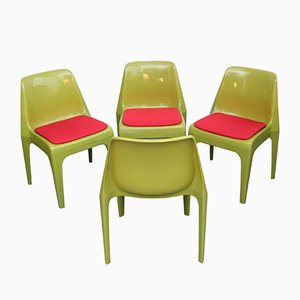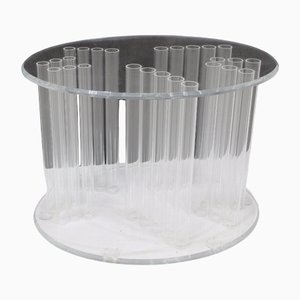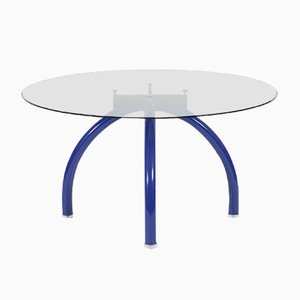How furniture went synthetic in the 20th century
Plastic Fantastic
-
Panton Chair by Verner Panton
Photo © Florian Böhm; courtesy of Vitra
-
Set of Hyatt Billiard Ball invented by John W. Hyatt ca. 1860
Photo © Gregory Tobias; courtesy of Chemical Heritage Foundation
-
Swiss-Made Bakelite Telephone manufactured by Albiswerk Zurich ca. 1930s
Photo © Gregory Tobias; courtesy of Chemical Heritage Foundation
-
Charles & Ray Eames
Courtesy of Eames-Office, LLC
-
La Chaise designed by Charles and Ray Eames ca. 1948
Photo © Nicole Bachmann; courtesy of Vitra
-
Eames Plastic Side Chair designed by Charles & Ray Eames ca. 1950
Photo © Florian Böhm; courtesy of Vitra
-
Eames Plastic Side Chair by Charles & Ray Eames
Photo © Florian Böhm; courtesy of Vitra
-
Tulip Chair designed by Eero Saarinen ca. 1953-1958
Courtesy of Knoll
-
Children's Chair K1340 (later K4999) designed by Marco Zanuso & Richard Sapper in 1964
Courtesy of Museo Kartell
-
Universale Chair designed by Joe Colombo ca. 1965-67
Courtesy of Studio Joe Colombo
-
Boby Portable Storage designed by Joe Colombo in 1969
Courtesy of Studio Joe Colombo
-
Tube Chair designed by Joe Colombo ca. 1969-70
Courtesy of Studio Joe Colombo
-
Verner Panton
Photo © Jens Bernsen; courtesy of Vitra
-
Panton Chair designed by Verner Panton ca. 1967-70
Photo © Florian Böhm; courtesy of Vitra
-
Panton Chair by Verner Panton
Photo © Florian Böhm; courtesy of Vitra
-
Throw-Away designed by Willie Landels in 1965 for Zanotta
Courtesy of Zanotta
-
Throw-Away by Willie Landels for Zanotta
Courtesy of Zanotta
-
Pastil Chair designed by Eero Aarnio 1967
Courtesy of Eero Aarnio Furniture
-
Bubble Chair designed by Eero Aarnio in 1968
Courtesy of Erno Aarnio Furniture
-
Quasar Khanh
Courtesy of Velvet Galerie
-
Pouf designed by Quasar Khanh ca. 1968
Photo © Mike Jayet; courtesy of Velvet Galerie
-
The Aerospace Collection designed by Quasar Khanh ca. 1968
<i>Photo © Mike Jayet; courtesy of Velvet Galerie</i>
-
Canapé Chesterfield designed by Quasar Khanh ca. 1968
Photo © Mike Jayet; courtesy of Velvet Galerie
-
Chair La Marie designed by Philippe Starck in 1999
Courtesy of Museo Kartell
-
Chair Louis Ghost designed by Philippe Starck in 2002
Courtesy of Museo Kartell
The sheer magnitude of plastics on the market today, and their ubiquity in almost every aspect of life, makes it hard to imagine that less than a century ago plastic was practically nonexistent. While contemporary ecological concerns make plastics less and less popular, many of the most iconic and innovative designs since the postwar era would have been impossible without the flexible, moldable marvels of the 20th century’s favorite synthetic material. Here, we tip our hat to our favorite groundbreaking designers, companies, and projects responsible for our collective plastic lexicon.
In the Beginning…
The story goes that celluloid, the first plastic to become industrially viable, was created by American inventor John W. Hyatt circa 1860. It debuted as an entry in a competition organized by a U.S. billiard ball company that was offering a $10,000 prize for the best ivory substitute. Hyatt didn’t win the ten grand, but his invention went on to earn him considerable commercial success—and a place in the history books—while launching a global quest for synthetic materials sure to cure every limitation and deprecation imposed upon mankind. The dream of durable pantyhose, affordable wall-to-wall carpeting, and light, easy-to-clean furniture for all begins!
Despite ongoing explorations into plant-derived cellulose, including some modified natural polymers like rayon, the next major development in plastics didn’t come until after the turn of the century when the Belgian-American chemist Leo Hendrik Baekeland invented the first completely synthetic plastic, Bakelite (pronounced bey-kuh-lahyt). A few decades later, Lucite (also known as Acrylite and Perspex) came onto the market, following years of research in various chemical labs around the world. Between the 1920s and 1950s, these early plastics were used in everything from buttons and pipes to radios and telephones, as well as bomb casings and other components of war machinery and armaments. The Depression that followed WWI is often cited as a driving force in the popularization of plastics, since many had lost their fortunes but not their desire to accessorize— allowing Bakelite, Lucite, and the like to dominate the era’s costume jewelry.
Postwar Promise
While the earlier versions of plastic were just too heavy and unwieldy to become serious players in modernist furniture design, the postwar United States presented uniquely fertile ground for the development and propagation of plastics. The baby boom alongside the influx of European refugees brought about a housing shortage and a growing need for affordable, space-saving designs. At the same time, wartime industries shifted their high-tech expertise toward the production of mass-market goods, while American consumers felt the benefits of the expanding economy. Optimism toward the future permeated American society from top to bottom.
In January 1948, the Museum of Modern Art announced the International Competition for Low-Cost Furniture Design—which turned out to be an important milestone in the history of plastics in design. American architect Donald Knorr won first prize in the seating category (in a tie with Georg Leowald) with a chair that was initially conceived as a shell of thick, thermal plastic. Knorr’s chair was eventually put into production by Knoll using sheet-steel coated in flexible paint after the casts and molds for the plastic version proved too expensive.
Charles and Ray Eames—whose quest for affordable, high quality furniture designs began as early as 1940—also entered the MoMA competition with two designs intended to exploit the potential of plastic, at least in theory: comfortable without padding and easily mass-produced. Fiberglass technology (plastic reinforced with glass fibers) lifted from the automobile industry and developed in partnership with the Herman Miller Furniture Company facilitated the lucrative mass-production of the Eames DAX chair after it placed second in the competition (production was later continued by Vitra). La Chaise, the Eames’ 1948 molded plastic and fiberglass design, with its graceful lines and stunning combination of materials, whilst not prize-winning in 1948, went on to become an absolute icon in design history. The La Chaise was considered too expensive to produce in the postwar market, but was eventually revived by long-time Eames partner, Vitra, in 1996.
The Nifty ’50s
In 1953, Eero Saarinen hoped to end, as he famously decreed, the “tyranny of legs,” with his acclaimed Tulip Chair. Again, the plastics of the era were not yet up to the challenge posed by Saarinen’s imagination, and the piece debuted with a seat in molded fiberglass and a base in cast metal, both parts painted to appear as one. This was but one step toward the modernist holy grail: a chair produced in one material, in a single molding process.
The ’50s was also the decade when Kartell, the company whose name was to become synonymous with innovation in plastic designs found its footing. Immediately imposing its dominance, Kartell picked up the first Compasso d’Oro award in 1955 and two more in 1957 and 1959 for its revolutionary lines of plastic kitchenware.
The Swingin’ ’60s (&’70s)
Kartell founded its Habitat division in 1963, thereby expanding from homewares and lighting into furniture in plastics. The production house’s groundbreaking designs during this era included the 1964 K1340 (later called the K 4999) children’s chair—according to Kartell the world’s first all-plastic chair. Three years later, Kartell premiered another first with designer Joe Colombo: the first-ever industrially finished plastic chair. The Universale chairs were extremely versatile—modular in height, stackable, and available in a range of colors.
The body-contour trend begun by Eames and Knorr met with advancements in plastics technology and was taken to its logical conclusion in another all-time classic: the 1967 Panton Chair by Verner Panton. Vitra championed Panton’s design from its inception, and current Chief Design Officer Eckart Maise calls the iconic piece “the perfect balance of technology, material, and aesthetics.” The Panton Chair was the first to be manufactured completely out of plastic in one single piece; as Maise notes, it epitomizes expression of the material, combining an innovative cantilever structure with an anthropomorphic shape for comfort and extreme elegance of form. Vitra continues to produce the wildly popular design today, now offering it in two variations—the high gloss, luxurious Panton Chair Classic and, since 1999 (when the designer’s original idea was finally able to be fully realized due to progress in the stability and strength of the plastics), the affordable, matte-finish Panton Chair.
Talking about the arc of plastics in design over the last half century, Maise notes that in the beginning, plastic was a completely new world; unchartered territory for adventurous designers. The new material allowed development of three-dimensional shapes and color experimentation that had been impossible previously. Gaetano Pesce, avant-garde Italian designer and architect, was responsible for some of the more surreal design concepts of the mid to late 20th century. His series of UP armchairs and ottomans in the late 1960s—another Vitra partnership—used polyurethane foam to create expansive, Pop Art-influenced forms that were the natural counterpoint to the rigid plastic designs of Panton, Eames, et al. The UP chairs could be vacuum packed, thus reducing to about 10% of the initial volume, for easy transport before assuming the original shape when the wrapper was removed.
The flamboyance of the ’60s intersected with material developments in plastics to give rise to some of the most memorably eccentric designs of the last century. Pieces like Willie Landel’s Throw-Away Sofa—designed in 1965 from expanded polyurethane with a fabric or leather cover and manufactured by Zanotta—questioned the traditional, bourgeois notions of permanence, security, and material assets. Finnish visionary Eero Aarnio fully exploited the, well, plasticity of the material in the mid-1960s with his fun-yet-functional Ball, Bubble, and Pastil Chairs. And the Vietnamese-French designer and inventor Quasar Khanh, the “architect of air,” pushed the boundaries of fantasy and design with his collection of inflatable furniture—including the definitive Aerospace series in 1968. The pieces were effectively hand-made, albeit in PVC, and produced by a beach toy factory in Paris until the early 1970s.
Characterized by its superlative surface quality, luster, and colorfastness, ABS (a thermoplastic polymer notably also used by Lego as well as Ettore Sottsass in his work for Olivetti ) was a staple material of Kartell’s groundbreaking designers. The first entirely plastic bookshelf—Giulio Polvara’s 1975 4760/4765 stackable, modular system—used the material, as did Anna Castelli Ferrieri as few years prior with her revolutionary, rounded, modular, mobile storage units, the Componibili series (1969), also manufactured by Kartell and one of the company’s bestsellers to this day. Ferrieri is a colossus in plastic design, winning numerous awards for objects ranging from her 4870 Stackable Chair in 1987 to a collection of beautiful and practical tableware for Kartell in 1976.
Not all designers in the 1960s and ’70s were focused on the affordability or revolutionary possibilities of the new material, though. At the higher end of the spectrum, designers like Karl Springer, Vladimir Kagan, and Gaetano Sciolari were all working with the durable yet chic medium of acrylic glass. Maria Pergay, unassailable queen of stainless steel, was quick to see the potential of plastics, combining pristine Plexiglass with clinical steel to impossibly elegant effect in epochal works like the Acier Chairs, circa 1969.
The New Millennium
From the color and design flair of the ’60s and ’70s to the high performance plastics of the ’80s and ’90s, the designs produced became more focused on stability and the constructive, technical characteristics of the material. Pergay’s countryman Philippe Starck—who, incidentally, had been a disciple of Khanh’s—is perhaps the best-known name in plastic design from the late 20th century. Starck’s La Marie Chair in 1999 for Kartell was the world’s first transparent polycarbonate chair and brought some of the immaculate luxury of predecessors like Pergay into a realm accessible to a far broader demographic. Starck’s partnership with Kartell also generated the breakthrough Louis Ghost chair in 2002.
Looking back at a century of innovations in plastic, the path from scientific experimentation to artistic expression and popular adaptation is remarkable. Institutions like the Museo Kartell and Vitra Design Museum were established at the turn of the 21st century to preserve the icons of 20th century plastic designs, and also to contribute to essential research into the conservation and restoration of some of the earlier, less stable plastic materials (the foam pieces from the ’60s, for example, are particularly vulnerable). Vitra’s Eckart Maise opines that “none of the contemporaries will have the importance to the material of plastics as the pioneers.” And yet, innovation is far from dead. In terms of new technologies, the focus has now shifted to renewable materials, bio-resins, and other non-oil-based plastic alternatives. In accordance with the ecological concerns of our time, we often see a more sober approach to experimental materials; a rather dramatic shift from some of the wild exploration and flights of fancy of the latter half of the last century. There is, however, one thing that we can be sure of—design at the cusp of technological vicissitudes is always going to be fascinating, at times unpredictable, and, every once in a while, even revolutionary.
Many thanks to the Chemical Heritage Foundation, Studio Joe Colombo, Eero Aarnio Studio, Velvet Galerie, Museo Kartell, Knoll International, Vitra, and Zanotta for sharing so many plastic fantastic images!
-
Text by
-
Gretta Louw
A South-African born Australian currently based in Germany, Gretta is a globetrotting multi-disciplinary artist and language lover. She holds a degree in Psychology, and has seriously avant garde leanings.
-
More to Love
German Red and Green Plastic Chairs, 1970s, Set of 4

Italian Multicolor Boby Unit by Joe Colombo for Bieffeplast, 1968

Large Vintage Acrylic Glass Table, 1970s

Brown Plastic Chair by Eerio Aarnio for UPO Furniture, 1970s

Spyder Dining Table by Ettore Sottsass for Knoll, 1984



























 Joe Colombo
Courtesy of Studio Joe Colombo
Joe Colombo
Courtesy of Studio Joe Colombo
